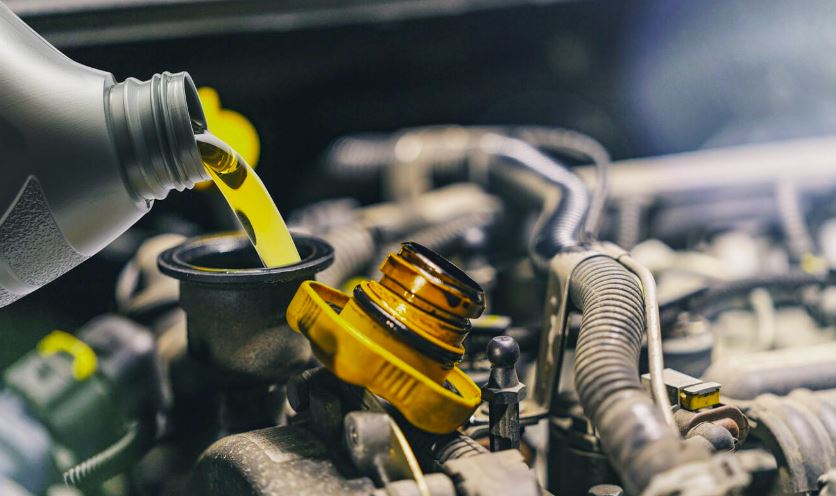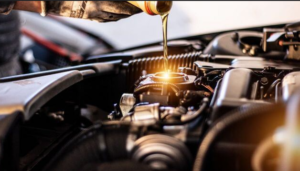Mixed Hydrocarbon Oil: What You Need to Know
What is Mixed Hydrocarbon Oil?
Mixed hydrocarbon oil, often referred to as MHO, is a versatile and complex mixture of various hydrocarbons. These hydrocarbons typically include alkanes, alkenes, and aromatics, each contributing unique properties to the final product. MHOs are commonly derived from crude oil through refining processes that separate and blend these different hydrocarbon types.
Types of Hydrocarbons Used as Lubricants
Mixed hydrocarbon oils can be categorized based on their molecular structure, boiling point range, and intended applications. Below are the primary types:
1. Paraffinic Hydrocarbon Oils
Paraffinic hydrocarbon oils consist mainly of saturated hydrocarbons (alkanes). They have high oxidation stability, making them ideal for lubricants, transformer oils, and white oils. They offer good viscosity and thermal stability.
Applications:
Automotive and industrial lubricants
Transformer and electrical insulating oils
Pharmaceutical and cosmetic industries (white oil)
2. Naphthenic Hydrocarbon Oils
Naphthenic hydrocarbon oils contain cycloalkanes, which provide excellent solvency and low-temperature properties. These oils are widely used in rubber processing, adhesives, and metalworking fluids.
Applications:
Rubber process oils
Metalworking fluids and cutting oils
Transformer oils
3. Aromatic Hydrocarbon Oils
Aromatic hydrocarbon oils contain benzene-based structures and are highly effective in applications that require excellent solvency. They are often used as industrial solvents and feedstocks in the production of synthetic rubber and resins.
Applications:
Industrial solvents
Ink and dye manufacturing
Synthetic rubber production
4. Light Hydrocarbon Oils (Solvents and Fuels)
Light hydrocarbon oils include gasoline, naphtha, and other low-boiling-point fractions. These oils are used in fuels, cleaning agents, and chemical processes requiring fast evaporation and high solvency.
Applications:
Fuels (gasoline, aviation fuel, diesel)
Paint thinners and degreasers
Chemical synthesis feedstock
5. Heavy Hydrocarbon Oils (Residue and Lubricants)
Heavy hydrocarbon oils include residual oils and high-viscosity lubricants used in heavy machinery and marine applications. These oils have high carbon content and are often processed further into bitumen and asphalt.
Applications:
Marine fuels (bunker oils)
Industrial lubricants
Asphalt and bitumen production
Properties and Characteristics of Mixed Hydrocarbon Oils
Mixed hydrocarbon oils possess varying physical and chemical properties depending on their composition. Some key characteristics include:
Viscosity: Determines flow characteristics and lubrication performance.
Solvency: Affects the oil’s ability to dissolve substances, crucial for solvents and industrial cleaners.
Thermal Stability: Resistance to high-temperature degradation.
Oxidation Stability: Resistance to breakdown when exposed to oxygen, impacting shelf life and effectiveness.
Flash Point and Boiling Range: Defines the oil’s volatility and suitability for specific applications.
MHO Diesel Uses
MHO (Methyl Hexahydrophthalate) diesel is a type of oxygenated diesel fuel additive derived from esters. Its primary uses include:
Fuel Additive – Improves combustion efficiency and reduces emissions (CO, HC, and soot).
Cetane Booster – Enhances ignition quality for smoother engine performance.
Lubricity Enhancer – Protects fuel injection systems by reducing wear.
Cold Flow Improver – Helps prevent diesel fuel gelling in low temperatures.
Biofuel Component – Sometimes blended with biodiesel for better stability.
MHO diesel is mainly used in automotive, marine, and industrial diesel engines to meet environmental regulations and improve fuel economy.
The Composition of Mixed Hydrocarbon Oil
Understanding the composition of mix hydrocarbon oil or hydrocarbons in oil is crucial for comprehending its applications and benefits. The blend typically includes:
Alkanes: These are saturated hydrocarbons with single bonds, known for their stability and non-reactive nature. Examples include methane, ethane, and propane.
Alkenes: These unsaturated hydrocarbons contain one or more double bonds, making them more reactive. Examples include ethylene and propylene.
Aromatics: These hydrocarbons contain benzene rings, contributing to the oil’s solvency and stability. Examples include benzene, toluene, and xylene.
The varying proportions of these components give mixed hydrocarbon oils their unique properties, making them suitable for different industrial applications.
Production of Mixed Hydrocarbon Oil
The production of mixed hydrocarbon oil involves several refining processes that ensure the right balance of hydrocarbons is achieved. Key steps include:
Distillation
Distillation is the initial step where crude oil is heated and separated into different fractions based on boiling points. This process helps in isolating the different hydrocarbon chains present in crude oil.
Cracking
Cracking breaks down larger hydrocarbon molecules into smaller ones. This can be done through thermal cracking, catalytic cracking, or hydrocracking, each method offering different advantages in terms of efficiency and output quality.
Blending
After the distillation and cracking processes, various hydrocarbon fractions are blended to create the desired mixed hydrocarbon oil. The blend ratio depends on the intended application of the MHO.
The Refining Process
The refining process for mixed hydrocarbon oil involves several stages:
Distillation: Crude oil is heated, and its components are separated based on their boiling points.
Cracking: Larger hydrocarbon molecules are broken down into smaller, more useful ones.
Reforming: Hydrocarbons are rearranged to form higher-octane products.
Blending: Different refined products are mixed to achieve the desired composition and properties of the final mixed hydrocarbon oil.
Applications of Mixed Hydrocarbon Oil

Fuel
Solvents
Lubricants
Feedstock for Petrochemicals
Benefits of Mixed Hydrocarbon Oil
Versatility
The diverse composition of mixed hydrocarbon oil makes it suitable for multiple applications, ranging from fuel to solvents and lubricants.Efficiency
MHO oil provide high energy output, making them an efficient fuel source for engines and power generation.Stability
The presence of aromatic hydrocarbons contributes to the stability and longevity of mixed hydrocarbon oil, making it a reliable choice for various industrial applications.Cost-Effectiveness
Compared to other specialized oils, mixed hydrocarbon oil is often more affordable due to the efficient refining processes and abundant availability of crude oil.Environmental Impact of Mixed Hydrocarbon Oil
While mixed hydrocarbon oil offers numerous benefits, it also has environmental implications that need to be considered.
Emissions
Combustion of mixed hydrocarbon oil can release greenhouse gases and other pollutants into the atmosphere. Efforts to reduce emissions through cleaner technologies and alternative fuels are ongoing.
Spills and Leaks
Accidental spills and leaks during the extraction, transportation, and storage of mixed hydrocarbon oil can have severe environmental consequences, contaminating soil and water bodies.
Resource Depletion
The extraction of crude oil, the primary source of mixed hydrocarbon oil, contributes to the depletion of natural resources. Sustainable practices and the development of renewable energy sources are essential to address this issue.
Future of Mixed Hydrocarbon Oil

Technological Innovations
Advancements in refining technologies are enhancing the efficiency and environmental performance of mixed hydrocarbon oil production. Innovations such as catalytic reforming and hydroprocessing are paving the way for cleaner and more efficient MHOs.Regulatory Changes
Stringent environmental regulations are influencing the production and use of mixed hydrocarbon oil. Compliance with these regulations is driving the adoption of cleaner technologies and alternative fuels.Market Trends
The global energy market is evolving, with increasing emphasis on renewable energy sources. While mixed hydrocarbon oil remains a significant player, its role is expected to change as the demand for sustainable energy solutions grows.MHO Diesel Vs Diesel
Final Thoughts
FAQs
Mineral Hydrocarbon Oil is a petroleum-derived liquid composed of saturated hydrocarbons. It is widely used in industries such as pharmaceuticals, cosmetics, food processing, and lubricants. Depending on its purity, it can be classified into technical, food-grade, or medicinal grades. Known for its stability, non-reactivity, and lubricating properties, mineral hydrocarbon oil is commonly found in skincare products, machine lubrication, and as a processing aid in food production.
Safety concerns include the risk of spills during extraction, transportation, and storage, as well as health risks from exposure to hydrocarbons, such as respiratory issues, skin irritation, and potential long-term effects like cancer.
Environmental regulations aim to reduce the emissions and environmental damage associated with hydrocarbon oil production and use, driving innovation in refining processes and the development of more sustainable practices.
Advancements include the development of bio-based hydrocarbons from renewable sources, improved refining techniques to enhance efficiency and reduce emissions, and research into alternative energy sources to decrease reliance on fossil fuels.
The refining process separates and alters the components of crude oil through techniques like distillation, cracking, and reforming, resulting in a final product with a specific composition and set of properties suitable for various applications.
Alkanes are saturated hydrocarbons with straight or branched chains. Cycloalkanes are saturated hydrocarbons with ring structures. Aromatic hydrocarbons contain one or more aromatic rings and are unsaturated, having double bonds within their ring structures.

What Are the Latest Trends in Sustainable Industrial Oils for UAE Manufacturers?
What Are the Latest Trends in Sustainable Industrial Oils for UAE Manufacturers? Discover More Industrial oils form the lifeline of heavy industries, enabling machines, turbines, compressors, and production lines to function seamlessly. They reduce friction, cool equipment, prevent wear, and ensure uninterrupted operations. In a fast-developing economy like the UAE—where energy, petrochemicals, construction, and manufacturing drive growth—industrial oils are indispensable. But today, the conversation around industrial oils is no longer limited to performance. Global concerns about climate change, carbon emissions,

UAE Brake Fluid – DOT 4 vs. DOT 5.1 Which One Should Use
UAE Brake Fluid – DOT 4 vs. DOT 5.1 Which One Should Use Discover More Brake fluid is one of the most critical yet often overlooked components in a vehicle’s braking system. It plays a pivotal role in ensuring that when you press the brake pedal, your car comes to a smooth and controlled stop. In the United Arab Emirates (UAE), where extreme heat, high-speed driving, and heavy traffic are common, selecting the right brake fluid is not just a

What Is a TBN Booster Additive & Why Does Your Engine Need It?
What Is a TBN Booster Additive & Why Does Your Engine Need It? Discover More Engines are the heart of any vehicle, and their longevity depends heavily on the quality of lubrication they receive. Over time, engine oil degrades due to heat, friction, and chemical reactions, leading to acid buildup, sludge formation, and increased wear. To combat these issues, TBN (Total Base Number) Booster Additives play a vital role in maintaining oil stability and engine health. In this guide we’ll explore: What TBN is and why

How Anti-Oxidants in Fuel Additives Can Save You Thousands on Repairs
How Anti-Oxidants in Fuel Additives Can Save You Thousands on Repairs Discover More Every time you start your car, an invisible chemical reaction is taking place that could be costing you hundreds – even thousands – of dollars in unnecessary repairs. Fuel oxidation, the process where gasoline or diesel breaks down when exposed to oxygen, is one of the most overlooked yet destructive forces affecting modern engines. The shocking truth? Studies show that untreated fuel can begin degrading in as

What is Transformer Oil? Types, Properties & Uses Explained
What is Transformer Oil? Types, Properties, Uses, and Comparisons Discover More Transformer oil is a critical component in electrical power systems, ensuring the efficient and safe operation of transformers. It acts as both an insulator and a coolant, preventing electrical breakdowns and dissipating heat generated during transformer operation. In this detailed guide, we will explore what transformer oil is, its different types, key properties, applications, maintenance, and how to choose the best oil for your needs. We’ll also introduce Rumanza

Does Your Car Need High Mileage Oil? (Signs You Should Switch)
Does Your Car Need High Mileage Oil? (Signs You Should Switch) Discover More As vehicles age, their engines undergo significant wear, leading to reduced efficiency and potential breakdowns. One of the most effective ways to maintain an older engine is by switching to high-mileage oil, specially formulated for cars with 75,000 miles or more. But how do you know if your car needs it? What are the key benefits, drawbacks, and alternatives? And why should you consider Ruamnza Xrace Pro Oil for your high-mileage vehicle?

Does Your Diesel Engine Need a Special Oil? (The Truth Revealed)
Does Your Diesel Engine Need a Special Oil? (The Truth Revealed) Discover More When it comes to maintaining a diesel engine, one of the most critical decisions you’ll make is choosing the right oil. Diesel engines operate under extreme conditions—high compression, intense heat, and heavy loads—which means they require a lubricant that can withstand these challenges. But does your diesel engine really need a special oil, or can you use any high-quality motor oil? In this comprehensive guide, we’ll uncover the

What is Anti-Freeze Coolant? Types, Colors & How to Use
What is Anti-Freeze Coolant? Types, Colors & How to Use Discover More Anti-freeze coolant, also known as engine coolant or radiator fluid, is a specially formulated liquid that regulates engine temperature, prevents overheating in summer, and protects against freezing in winter. It is a mixture of water, ethylene glycol or propylene glycol, and chemical additives that enhance engine efficiency and longevity. Without proper coolant, engines can suffer from: Overheating (leading to warped cylinder heads or blown gaskets) Freezing (causing cracked engine blocks in cold climates) Corrosion (damaging radiators,

What is ATF? Types of Transmission Fluid & When to Change It
What is ATF? Types of Transmission Fluid & When to Change It Discover More Transmission fluid is one of the most critical yet often overlooked components in a vehicle’s maintenance routine. Whether you drive an automatic, manual, continuously variable transmission (CVT), or dual-clutch transmission (DCT) vehicle, the right transmission fluid ensures smooth operation, longevity, and peak performance. What is Automatic Transmission Fluid (ATF)? Automatic Transmission Fluid (ATF) is a specialized lubricant designed to reduce friction, cool transmission components, and facilitate smooth

Fuel Injector Cleaner: Does It Really Work? (Analysis, Benefits, and Top Picks)
Fuel Injector Cleaner: Does It Really Work? (In-Depth Analysis, Benefits, and Top Picks) Discover More Modern engines rely on precise fuel delivery to maintain performance, efficiency, and emissions compliance. Fuel injectors play a critical role in this process by atomizing fuel into a fine mist for optimal combustion. However, over time, carbon deposits, varnish, and contaminants can clog injectors, leading to poor engine performance. Fuel injector cleaners are chemical additives designed to dissolve these deposits and restore injector efficiency. But do they

Best Railroad Engine Oils in 2025 – Boost Performance & Longevity
Best Railroad Engine Oils in 2025 – Boost Performance & Longevity Discover More The railroad industry is a backbone of global logistics, transporting millions of tons of cargo and passengers daily. Given the immense stress on locomotive engines, selecting the best railroad engine oil is crucial for optimal performance, fuel efficiency, and engine longevity. In 2025, advancements in lubrication technology have led to high-performance synthetic blends, low-ash formulations, and smart additives that enhance engine protection under extreme conditions. This guide
